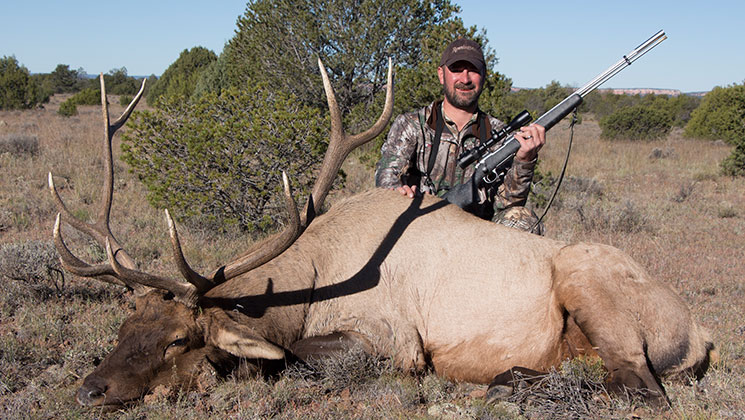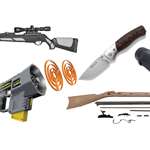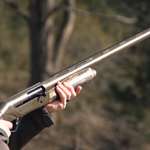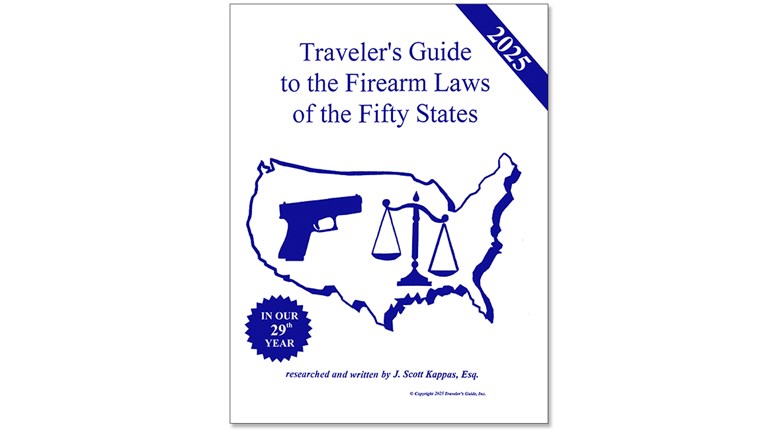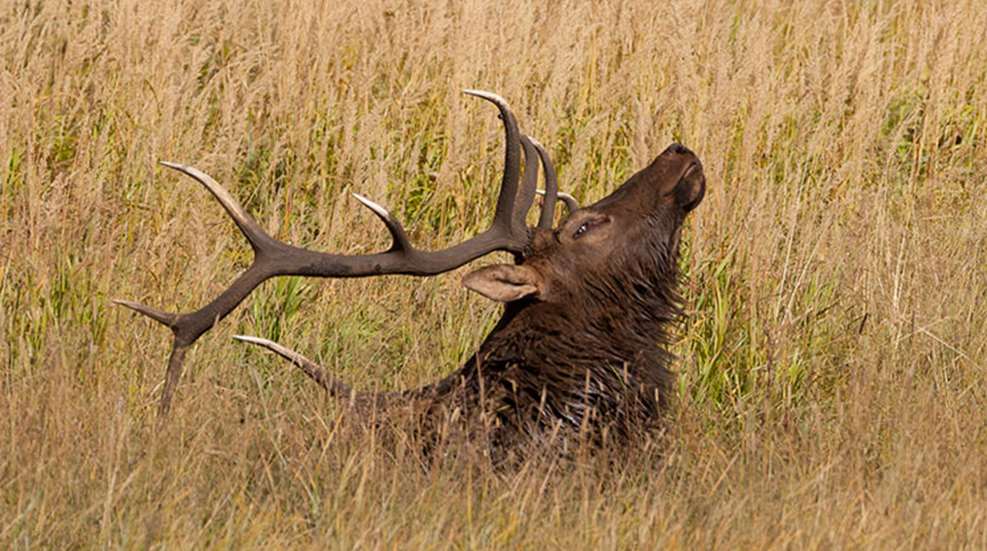
Bull elk grab you by your senses and then stomp on your soul. They beckon you with screaming bugles that you’ll chase for miles, then go silent without rewarding your efforts with so much as a glimpse of their glory. They make you sit for endless hours at a waterhole with nothing more than hope to keep you occupied. They provoke you with fresh tracks and shredded cedars, and every time you will respond with an enthusiasm that borders on foolishness, because you’ve learned that most of the time you will fail in your pursuit. You must be an optimist to be an elk hunter.
There are no guarantees when hunting elk, even when you’re carrying a tag that grants you access to 12,000 acres of private ranchland in New Mexico’s Unit 12. Even when the walls of the bunkhouse are covered with so many pictures of 350-inch bulls they appear common. Even when the last time four guys you know hunted this place, three of them went home with monsters. You go in thinking this is going to be a slam dunk, but the only thing slammed after four days of hunting from first light to last light is your spirit.
■■■
Mine was hurting when I crawled out of the truck on the last morning of hunting with Triangle T Outfitters south of Grants, N.M. The ranch where guide Troy Price and I spent every minute of the past week’s daylight was full of elk. Bulls taunted us each morning with the rising sun. Several responded to Troy’s cow calls. One even came within 50 yards of us—or at least he sounded that close; we never saw him.
The beauty of this portion of racehorse-trainer Danny Mirabal’s ranch was also its curse. A big plateau at 8,000 feet of elevation, the terrain befitted a landform often described as a tabletop. There was one draw with sides too gentle to qualify as a canyon, but most of the land was a series of wide, flat basins surrounded by low hills that rose at most 20 feet. Troy told me the hills were actually vents from an ancient and now inactive volcano, and the rises were formed eons ago by molten lava welling up from underground. The jagged, cinder-like rocks covering the hills and scattered throughout the basins made the footing tricky as they chewed at the soles of our boots.
Compared to the steep slopes and timber blowdowns that characterize elk habitat elsewhere, this was easy country. Easy to hike, yes. Easy to hunt, definitely not. The entire plateau, save for parts of the basins, was blanketed by cedars 10-30 feet tall. If we stood on a hill and found a lane through the brushy trees, we could see a 5-yard sliver of our territory stretching out to maybe 200 yards. Down on the flat ground, visibility was often less than half that. Glassing to find elk at a distance was futile.
And so our ears, not our eyes, led us to the bulls. Every morning Troy and I left the truck while it was still dark, shivering as much from nearby bugles as the chilly, predawn air of early October. Our simple tactic was to choose the nearest bull, close the distance and set up on the edge of a relatively open area that would give us a chance at spotting elk. The one good thing about the abundant cedars was they provided plenty of cover for us to hide in while Troy hummed on his cow call.
It seemed like we were going to luck out the very first morning. A bull on the other side of a slight rise stacked with cedars responded almost immediately to Troy’s sultry whines, and two more bugles later it sounded like the elk was just out of sight. As I tried to look through the trees for movement, I wondered how many words it would take to tell a story about a 30-minute elk hunt. A silent hour later, with nary a glint from a tine tip, I realized the ending wasn’t even close.
We found the tracks of that bull a good 300 yards from our hiding spot. I never would have guessed he was that far. Sound traveled clearly across the flat ground, and the sharp notes of the bugles made it difficult to gauge distance. Troy, too, admitted he was fooled and then stooped to examine the fresh marks in the sandy soil.
Both Troy and outfitter Ed Tibljas put a lot of emphasis on using tracks to estimate a bull’s size. They’ve trailed elk for decades, and Ed’s tracking experience stems from not only hunting big game but also serving in a highly trained military unit. Later that week Ed noted that an elk’s hooves grow throughout the animal’s lifetime, and he can usually tell a bull’s age within a year by looking at its tracks. Old bulls have larger tracks than cows and raghorns; they need big front feet to support the extra weight of their antlers, Ed explained.
Two things about the bugler’s tracks were quickly apparent: He had big feet, and he wasn’t alone. Several sets of smaller tracks—cows—ran alongside those made by the bull. This guy had a sizable harem, which was probably the reason he didn’t come closer.
“Didn’t want to leave the ladies,” said Troy, following the tracks with his eyes. “They’re heading back in, probably going to bed.”
We made a long loop of about 2 miles, hoping the bull would sound off again, but all we heard was the light breeze whistling through innumerable cedars, sometimes bringing with it the musky scent of elk. The bulls were here, leaving their calling cards in the form of ravaged cedars leaking sticky sap, but they weren’t talking. As the sun climbed toward mid-morning, Troy suggested we hike back to the truck.
“We’ll be on top of elk before we see them,” he said. “We better not take a chance of bumping them off their beds.”
The rest of the day was a waiting game, spent staking out a nearby waterhole and hoping to ambush a thirsty bull. With the temperature rising into the 80s under a cloudless sky, the strategy made sense, and the hundreds of elk tracks dotting the muddy banks surrounding the water provided a good reason to stay put.
My rangefinder told me the waterhole’s near bank was 136 yards away; the far one was 171. Even though I was armed with a muzzleloader, I was confident shooting at those ranges. The Remington Ultimate Muzzleloader braced on the tripod in front of me was zeroed at 200 yards, and I could shoot 3-inch groups or better at that distance. Sitting on the slight slope formed by a volcanic vent with my back braced against a stubby pine, I was comfortable. Troy stretched out in the shade beside me, and perhaps under the mirror lenses of his sunglasses caught a short nap. The hours crawled by with no sign of elk except for a faint bugle behind us during the last half-hour of light.
■■■
Even though we didn’t see a single elk, it was still easy to have hope. It was, after all, only the first day of the hunt. Back at the bunkhouse, stories from other hunters in our group highlighting their encounters with bulls elevated my spirit even more. One guy had even passed on a couple 5x5s; the photos on the walls of giant racks towering over successful hunters persuaded him to wait for something bigger.
As the week wore on, though, hope began to give way to frustration. Bulls continued to bugle at first light and we continued to give chase, but rarely were we able to get a look at what we so earnestly pursued. One morning Troy worked a bull into a frenzy with his Primos Cow Girl call. Every couple minutes a bugle let us know the bull was coming closer. We heard cedar branches breaking, and then the bull screamed in our faces. He was so close he nearly made my ears ring, but he wasn’t close enough. In the thick cedars I could see only 30 yards, and the bull never showed himself. The half-hour of utter silence following his last bugle was deafening.
Just after sunrise on another morning we slipped within range of two buglers only to find they were raghorns, but Troy and I had our minds set on a mature bull. I was surprised at how quickly I decided to give up the chance of killing one of those elk. They were the first bulls we had seen all week, and there were but two days left to hunt. Influenced by photos and stories of past hunts, plus Ed’s reports of big 6x6s seen while scouting, my expectations were greater—but maybe unrealistic. Bulls spotted a week ago—and especially those killed last season—I could not count on now.
I had the rest of the day to think that over. By mid-morning Troy and I took our familiar positions by a waterhole, and the wait became a grind. I understood it was my best option, but that didn’t help the hours—all nine … now eight and a half … now eight ... of them—tick by any faster. Where are these big bulls? Text messages from my hunting partners, all of whom were also watching waterholes, caused my thoughts to wander. I began joking with myself: What do an American hunter, a German hunter and an Italian hunter have in common? None of them have ever killed an elk over a waterhole. What’s the difference between hunting elk at a waterhole and Obamacare? There’s been some success with Obamacare. I hated to admit it, but this was becoming boring.
Shadows slowly lengthened over the waterhole, and I got around to asking myself why I was so anxious to get out of there. How can I be bored? I’m elk hunting! All this will be gone in two days. I better enjoy every minute of it while I still can. Bulls or no bulls, in a few days I’m going to miss this. There are no waterholes in suburban Virginia.
Reflecting on the essence of the hunt made me feel a little ashamed for not appreciating it more, but the first ringing note of a nearby bugle immediately cleansed me of all guilt. I was here to kill a good bull, and this one could be it. He bugled again, closer still, but the light was fading fast. Twenty minutes later rocks rattled in the cedars, and he stepped into the clearing on the far side of the waterhole. The bull was in range at 205 yards, but even through the Swarovski he was just a dark silhouette against a gray backdrop. A 5x5, heavy and wide and untouchable because shooting light was gone. I had waited nine hours to miss my chance by a couple minutes.
Troy and I spent the next afternoon at the same spot, but neither the 5x5 nor any other elk showed. We didn’t even hear one. Instead of feeling defeated, I felt like I wasn’t even in the game. Back at the bunkhouse later that night, Ed’s report of surprising two monster bulls as he drove by another waterhole less than a mile away did little to boost my spirit.
■■■
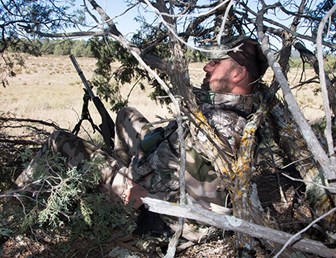 When Troy parked the truck on the last morning, there were no bugles to quicken our steps. We shouldered our packs and plodded west toward an area where we had heard a bull earlier in the week, but an hour passed with all remaining quiet. I was already steeling myself for another long sit at a waterhole when my ears caught a faint bugle. It was far off to the east but music to my ears.
When Troy parked the truck on the last morning, there were no bugles to quicken our steps. We shouldered our packs and plodded west toward an area where we had heard a bull earlier in the week, but an hour passed with all remaining quiet. I was already steeling myself for another long sit at a waterhole when my ears caught a faint bugle. It was far off to the east but music to my ears.
“Hear that, Troy?” I asked.
“No,” he replied. “Bull?”
“Yeah, but he’s a long way in the other direction, past the truck.”
“Tell me if he bugles again.”
Twenty-some years my senior, Troy had admitted on the first morning his hearing wasn’t as good as mine. A few minutes later the bull sounded off a second time, but my guide shook his head when I pointed in the direction of the bugle.
“I can’t hear him,” he said. “Let’s wait here a little and see if anything’s closer.”
Troy was a patient hunter, and I’m sure patience kills elk, but when the bull bugled again it was time for action.
“There he is, Troy. We gotta go!” I said. “That bull’s the only one bugling. Let’s get after him.”
“Lead the way,” replied my guide.
A brisk pace delivered us to the truck in 15 minutes, and about the same time passed before we stopped on the top of a hill. The bull was quiet while we made our hike, and Troy’s cow mew went unanswered. My guide looked at me and shrugged.
“Let’s keep going,” I said, committed to this bull like he was the sole turkey gobbling on a morning in mid-May. During the week I’d noticed the similarities between these elk and the turkeys back home: If we wanted to kill a bull, our best chance was to be where he wanted to go. Judging by the bugles I heard earlier, I was sure this bull was heading away from us, toward the southeast.
We dropped off the hill and followed it afoot for several hundred yards. Twice we paused for Troy to call. Nothing. I was losing confidence and starting to think we should have stuck to Troy’s plan when the bull bugled after a good 45 minutes of silence. My guide heard him loud and clear, and motioned for us to move forward.
Slipping quickly through the cedars brought us to the end of a narrow meadow about 30 yards wide and 100 yards long. Troy called, and the bull answered immediately. It sounded like he was just beyond the opening, but I had been fooled before. This time, though, the sound of hooves pounding the ground and clattering over rocks left no doubt we were close. Maybe too close.
“What happened?” I whispered. “Did we just spook the whole herd?”
“I don’t know,” Troy replied. “Did you see them?”
“No, but they must have seen us. Or smelled us. They’re gone.”
And then, incredibly, the bull bugled again. He had moved away, but he wasn’t spooked. We still had a chance, but we had to hurry to make up ground.
Trying our best to move fast without sounding like it, we had just skirted a fallen pine when the bull let us know he was hanging around. He seemed closer now, so we stopped. Ten minutes passed until we heard him again, but this time he sounded distant. Seconds later another bull, farther away to the south, mocked the one we were chasing with a bugle of his own.
The two bulls traded bugles for the next half-hour. It sounded like our bull was circling, maybe tending his cows and making sure the other bugler wasn’t intruding. He continued to move away, the second bull paralleling his route, but we were steadily gaining.
As Troy and I approached a wide, fairly open hillside, I looked toward the top to see high antlers skimming the horizon. The bull was just over the crest. Suddenly I was thankful for the cedars, as a stand of them running up the gradual slope provided cover as we climbed. Near the top I spotted a cow, then a spike bull. The bugler had to be close. I quickly ranged the spike at 193 yards, seeing in the field of view another cow appear from the shadows among a group of pines. Right behind her was our bull, and he was headed toward an opening.
This was going to happen quickly. The bull was relaxed and walking, but he would be through my only shooting lane in three or four strides. With the Remington pivoting on shooting sticks, I swung the reticle through the bull’s ribcage and pressed the trigger when the crosshair slid over the front of his shoulder. I heard the 250-grain Barnes bullet hit something solid but could see nothing, as the only thing in my scope was smoke. When it cleared, all I could see was cedars.
I discussed the shot with Troy while I tried to make my shaking hands reload the gun. Although the bull had been walking, I remembered to keep swinging and felt I made a good hit. Still, neither of us saw the bull’s reaction to the shot, and the smoke prevented us from seeing where the bull ran. Over text messages we consulted with Ed, who told us to wait 20 minutes before following up.
Those 20 minutes seemed longer than nine hours at a waterhole. Troy and I glassed the area over and over, but the cedars blocked our view. We recapped the morning and talked about how a long shot at a far-away bugle ended in a rush to close the distance. We reviewed the week while realizing that connecting with game on the last morning fills the mind and the soul as much as the tag. We celebrated elk hunting and prayed about the outcome.
Taking five steps when the wait was over and seeing the bull piled up near the spot where he last stood was almost anticlimactic. Yet it was fitting. The bullet caught the front portion of the elk’s lungs and bored into its spine ahead of the shoulders. One final lunge took the bull out of our sight before he fell—hidden completely behind a cedar.
To hunt New Mexico, Colorado or Texas with Triangle T Outfitters, call Ed Tibljas at 817-279-3132 or visit his booth at the NRA Great American Outdoor Show Feb. 6-14, 2016, in Harrisburg, Pa.
